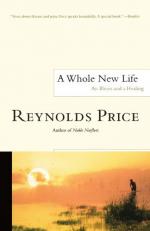
|
| Name: _________________________ | Period: ___________________ |
This test consists of 15 multiple choice questions and 5 short answer questions.
Multiple Choice Questions
1. What did MRIs indicate about Price's tumor, in 1987?
(a) No growth.
(b) Aggressive growth.
(c) Reduction in size.
(d) Decay of the vertebrae around it.
2. Where does Daniel Voll live with Reynolds Price?
(a) In Durham, NC.
(b) Washington D.C.
(c) Raleigh, NC.
(d) New York.
3. What kinds of subjects does Price say he steered his students toward?
(a) Science fiction.
(b) Highly-stylized works.
(c) Intensely literary works.
(d) Real emotions.
4. What was different about Daniel Voll's visit, when he returned to see Price?
(a) Price was more grateful for what Dan had experienced with him.
(b) Price was more remote on account of his pain.
(c) Price was more in control of his pain.
(d) Price was resentful to think of the conditions Dan had seen him in.
5. What does Price say he withdrew from?
(a) Anti-inflammatory drugs.
(b) Regular hospital care.
(c) Steroids.
(d) Radiation.
6. What did Price's friends the Andersons offer to do for him?
(a) Build a wing on their house for him to stay in.
(b) Help him with his medical bills.
(c) Find him funding for experimental treatments.
(d) Assume legal responsibility for his care.
7. How long after biofeedback and hypnosis was Price pain-free?
(a) A year.
(b) Eight weeks.
(c) Eight months.
(d) Eight visits.
8. What did Price become aware of after biofeedback?
(a) Scents and colors.
(b) Emotions.
(c) Repressed memories.
(d) Nature.
9. What does Price say his friends thought about his condition?
(a) They thought he was on the verge of recovery.
(b) They thought he was in retreat from the world.
(c) They thought he was dying of AIDS.
(d) They thought he was harboring his strength for fighting his cancer.
10. What had Price learned about pain, in biofeedback?
(a) To embrace the pain.
(b) To relax each muscle individually.
(c) Not to focus on his pain.
(d) To shut off his emotional reaction to his pain.
11. What was Dr. Shuping's prognosis?
(a) That Price's outlook for walking was not good.
(b) That surgery might help him.
(c) That he would likely be paralyzed permanently.
(d) That he might eventually get some relief from pain.
12. What did Reynolds Price find when he finally went to the hospital?
(a) He had damaged his vertebrae.
(b) He had injured his nerves.
(c) He had become diabetic.
(d) His immune system was malfunctioning.
13. What does Price say made physical therapy bearable?
(a) The drugs he took for pain.
(b) The physical progress.
(c) The process of learning new skills.
(d) The other patients.
14. What did Price learn to do in biofeedback?
(a) Focus on particular parts of his body.
(b) Breathe into his muscles.
(c) Isolate his muscle movements.
(d) Regulate his pH.
15. What does Price say his health was doing while he was writing the commissioned work?
(a) Remaining steady.
(b) Improving.
(c) Oscillating wildly.
(d) Declining.
Short Answer Questions
1. Who commissioned Price's work?
2. What was the result of the surgery Price had in the fall?
3. What kind of program does Price say he entered after biofeedback?
4. Where did Price visit after David Lang became his assistant?
5. What changed that allowed Price to return to writing?
|
This section contains 535 words (approx. 2 pages at 300 words per page) |

|




